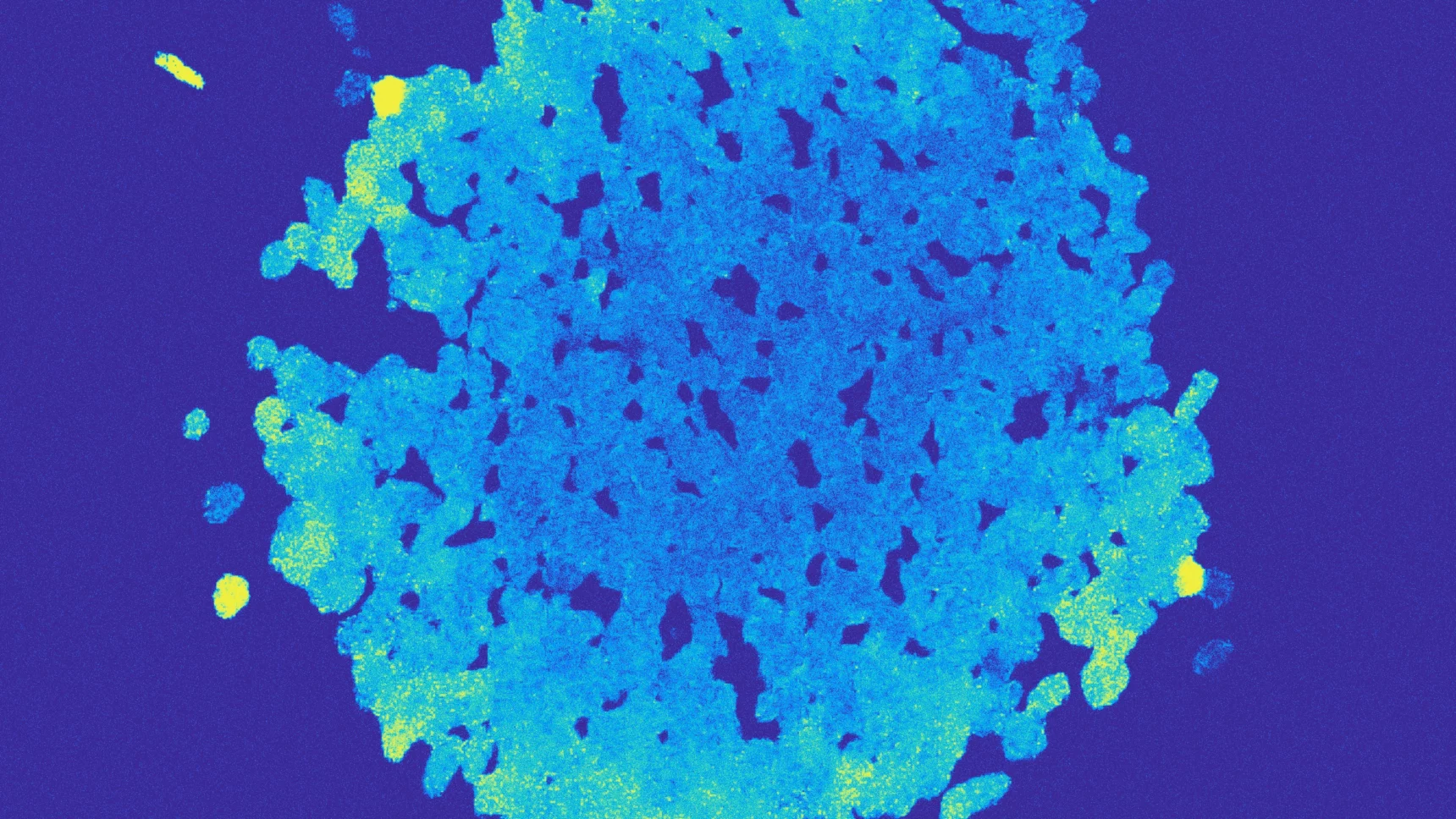A Dream of Discovering Alien Life Finds New Hope
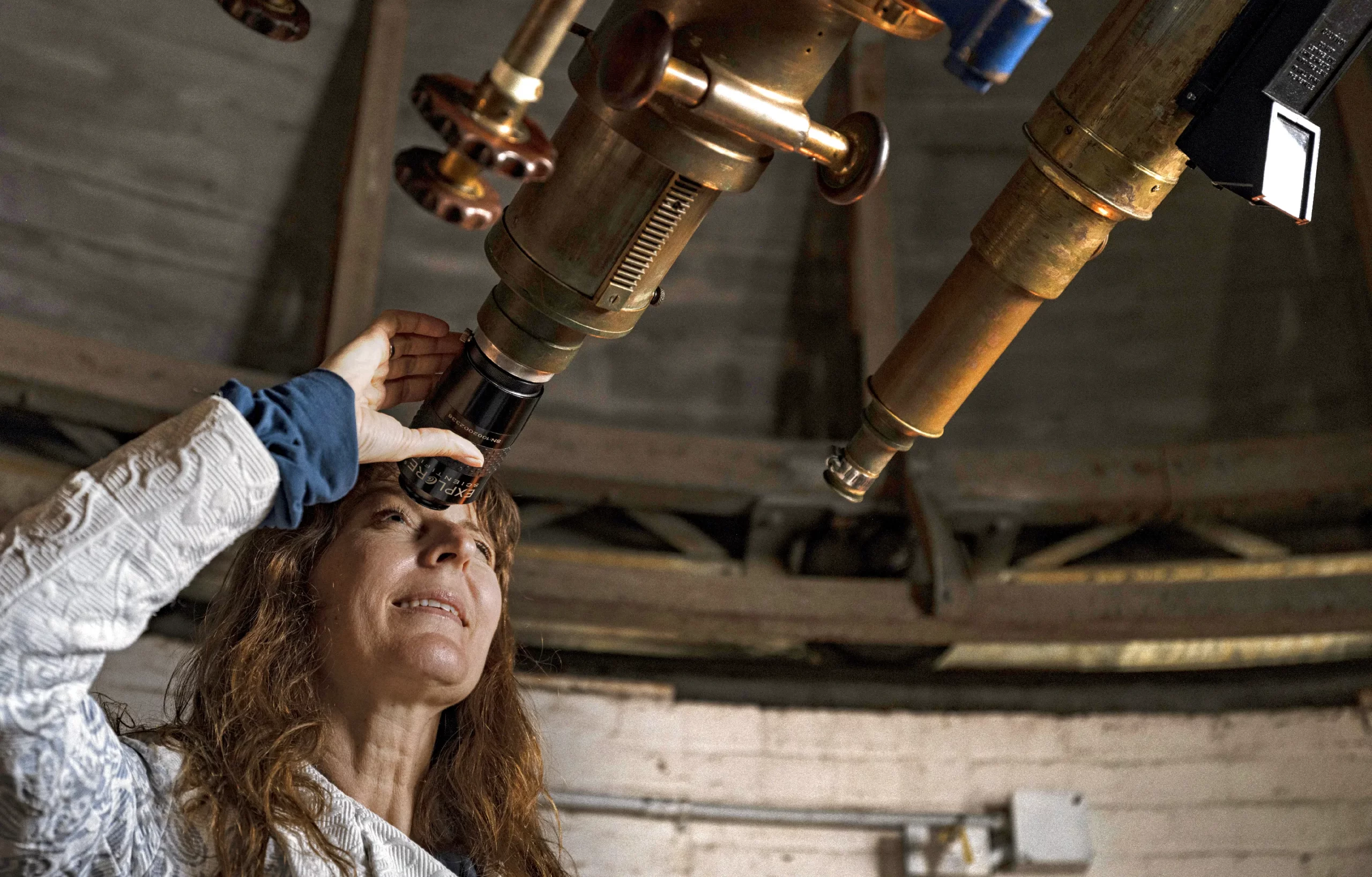
Lisa Kaltenegger, pictured at Cornell University’s Fuertes Observatory, hopes to identify the first candidate living planets.
Sasha Maslov for Quanta Magazine
Introduction
One of the many times Lisa Kaltenegger’s dream jolted a little closer toward reality was on a cold April morning a decade ago at an astronomy conference. She was clutching what she recalls was a terrible, just awful cup of coffee, not because she was going to drink any more of it but because she had waited in line and it was warm in her hands. Then Bill Borucki veered in her direction.
She readied herself to tell him to avoid the coffee. But Borucki, head of NASA’s Kepler mission, a space telescope designed to hunt for planets orbiting other stars (or “exoplanets”), had something else to discuss. Kepler had glimpsed its first two Earth-size exoplanets with a decent chance of having liquid water on their surfaces. These were the sort of strange new worlds that everyone at the conference — and possibly most of the human race — had imagined at least once. Would Kaltenegger confirm that the planets might be habitable?
Kaltenegger, at the time an astrophysicist at the Max Planck Institute for Astronomy in Heidelberg, Germany, started running new climate models before the conference was over, incorporating basic facts like the planets’ diameters and the lukewarm glow of their star. Her ultimate answer: a qualified yes. The planets might be suitable for life, or at least for liquid water; they could even be water worlds, encased in endless oceans without a single rocky outcrop poking above the waves. The caveat was that she would need more advanced observations to be sure.
Kaltenegger has since become perhaps the world’s leading computer modeler of potentially habitable worlds. In 2019, when another exoplanet-hunting NASA spacecraft called TESS found its own first rocky, temperate worlds, she was called on again to play the role of cosmic home inspector. Most recently, the Belgium-based SPECULOOS survey reached out for her help understanding a newfound Earth-size planet dubbed SPECULOOS-2c that’s precariously close to its star. She and her colleagues completed an analysis, uploaded as a preprint in September, showing that SPECULOOS-2c’s water could be in the process of steaming away like sauna vapor, as any seas of Venus did long ago and as Earth’s own oceans will begin to do in half a billion years. Telescope observations should be able to tell within a few years if that’s happening, which will help reveal our own planet’s future and further demarcate the knife’s-edge distinction between hostile and habitable worlds across the galaxy.
In simulating ersatz Earths and more speculative visions of living planets, Kaltenegger leverages the bizarre life and geology found on Earth to develop a more systematic set of expectations about what might be possible elsewhere. “I’m trying to do the fundamentals,” she told me during a recent visit to Cornell University, where she leads an institute named for Carl Sagan, another charismatic Ithaca-based astronomer with big ideas about ending humanity’s lonely sojourn in the cosmos.
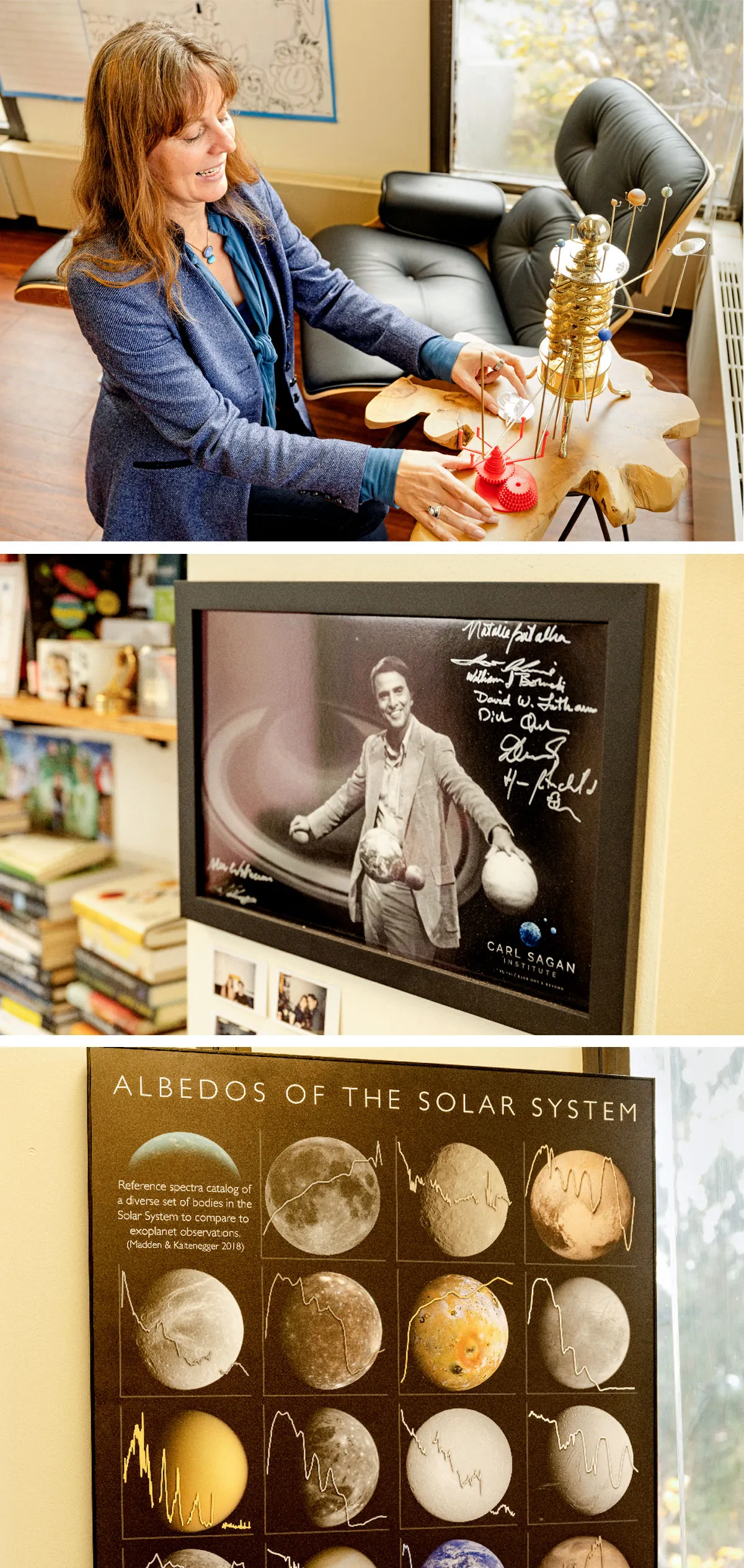
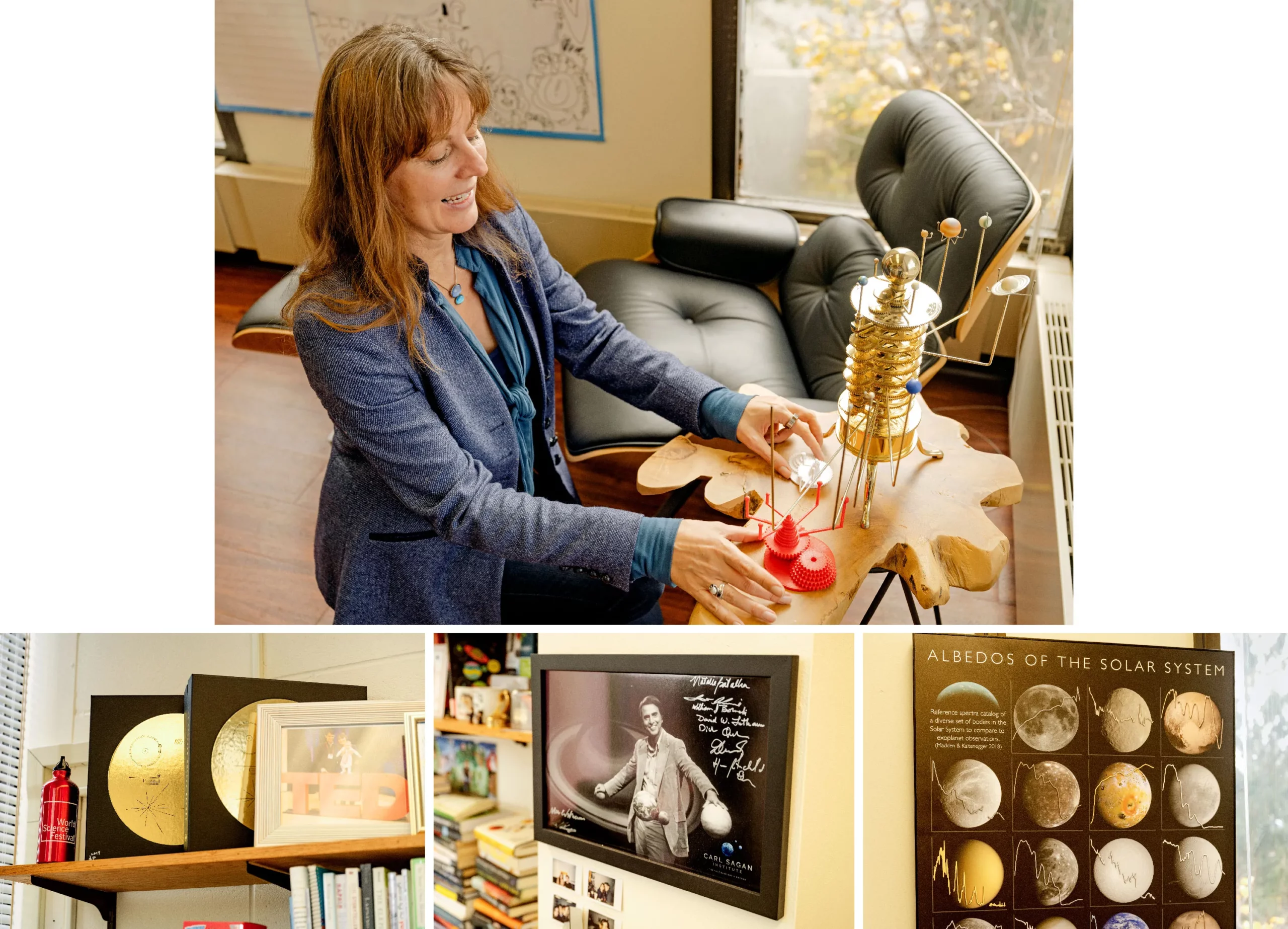
Kaltenegger’s office decor includes orreries, a copy of the gold plate that flew aboard the Voyager spacecraft, an autographed photo of Carl Sagan (who previously occupied the same office) and a poster of planetary spectra.
Sasha Maslov for Quanta Magazine
Kaltenegger’s office decor includes orreries, a copy of the gold plate that flew aboard the Voyager spacecraft, an autographed photo of Carl Sagan (who previously occupied the same office) and a poster of planetary spectra.
Sasha Maslov for Quanta Magazine
Her overarching quest — the search for alien life — is entering an unprecedented phase. Barring the bolt-from-the-blue arrival of something like an extraterrestrial radio broadcast, most astronomers believe that our best near-term chance of encountering other life in the cosmos is to detect biosignature gases — gases that could only have come from life — floating in exoplanets’ atmospheres. The sort of remote measurement necessary to make that kind of detection has strained the capabilities of even humanity’s most advanced observatories. But with the James Webb Space Telescope (JWST) now in its first few months of observations, such a discovery has become possible.
Over the next few years, the enormous space telescope will closely scrutinize a handful of rocky worlds that are regarded as most likely to be habitable, probably including the new SPECULOOS-2c. At minimum, JWST’s studies should discern whether these planets have atmospheres; they might also show that some are dripping with liquid water. Most optimistically — if biospheres bloom easily from Earth-like worlds — the telescope may detect odd ratios of, say, carbon dioxide, oxygen and methane on one of these planets. Astronomers may then be sorely tempted to attribute the concoction to the presence of an extraterrestrial ecosystem.
Finding biosignatures will require Kaltenegger and a small group of her peers to squeeze certainty from exceedingly few photons. Not only will the atmospheric signals they’re looking for be weak, but she and her colleagues must model a planet’s possible interplay of starlight, rock and air accurately enough to be sure that nothing besides life could explain the presence of a particular atmospheric gas. Any such analysis must navigate between a Scylla and Charybdis, avoiding both false negatives — life was there but you missed it — and false positives that find life where there is none.
Getting it wrong carries consequences. Unlike most scientific endeavors, the search for signs of extraterrestrial life happens under an unavoidable spotlight, and in a turbocharged information ecosystem where any scientist crying “Life!” warps the fabric of funding, attention and public trust. Kaltenegger herself recently had a front-row seat to just such an episode.
Her generation faces another pressure, one I intended to pose delicately but ended up blurting out just an hour after meeting her. She and her colleagues began their careers at the dawn of the era of exoplanets. Now they’re in a race to discover life on one before they die.
Planetary Dreamers
The modern search for biosignatures began almost immediately after the 1995 discovery of the first exoplanet — a gas giant — that orbited a sunlike star. Planet-hunting soon became fractious and competitive, a race for headlines. Some senior astronomers doubted that the flashy, resource-hungry subfield could deliver much more than one-off measurements of a few unique planets. “People were openly skeptical, and some people were angrily against it,” said Sara Seager, an exoplanet astronomer at the Massachusetts Institute of Technology. Meanwhile, enclaves of like-minded researchers started gathering at workshops to explore an open sky’s worth of new questions. “We never said no to any idea,” said Seager, who was a graduate student at the time.
Kaltenegger was a freshman at university when news of the first giant exoplanets dropped. She had grown up in a small town in Austria, with parents who supported her interests in math, physics and languages; the town librarians knew her so well they would give her the new books they hadn’t yet categorized. “Everything was possible,” she said of her upbringing. At the University of Graz, she was drawn to the new quest for new worlds. Seager, who met Kaltenegger at a summer school program in 1997, now lauds the remarkable boldness that led an undergraduate to join a subfield that was still so fringe and ephemeral. “Being able to be there at the beginning — it wasn’t just a coincidence,” Seager said. By the end of Kaltenegger’s undergraduate studies, she had coaxed funding from the European Union and invited herself into an open spot at an observatory in Tenerife on the Canary Islands. There she spent long, coffee-addled nights hunting exoplanets, listening to a postdoc’s Dire Straits album on loop before stumbling outside to see the sun rise over a lava-strewn landscape.
Meanwhile, the space agencies were getting in on the action. In 1996, a NASA administrator, Dan Goldin, publicized a plan that would effectively have sprinted straight from the discovery of the first gas giant exoplanets all the way to the end zone. His plan called for massive space-based observatories, dubbed Terrestrial Planet Finders, that could take detailed spectroscopic measurements of alien Earths, breaking their light into its component colors to understand their chemical makeup.
Better still, Goldin wanted actual pictures of planets. In 1990 NASA’s Voyager probe, at Sagan’s behest, had snapped a photo of home from out beyond the orbit of Neptune, reducing our entire living, breathing, fragile world to a pale blue dot suspended in a void. What if we could see another pale blue dot out there twinkling in the black?
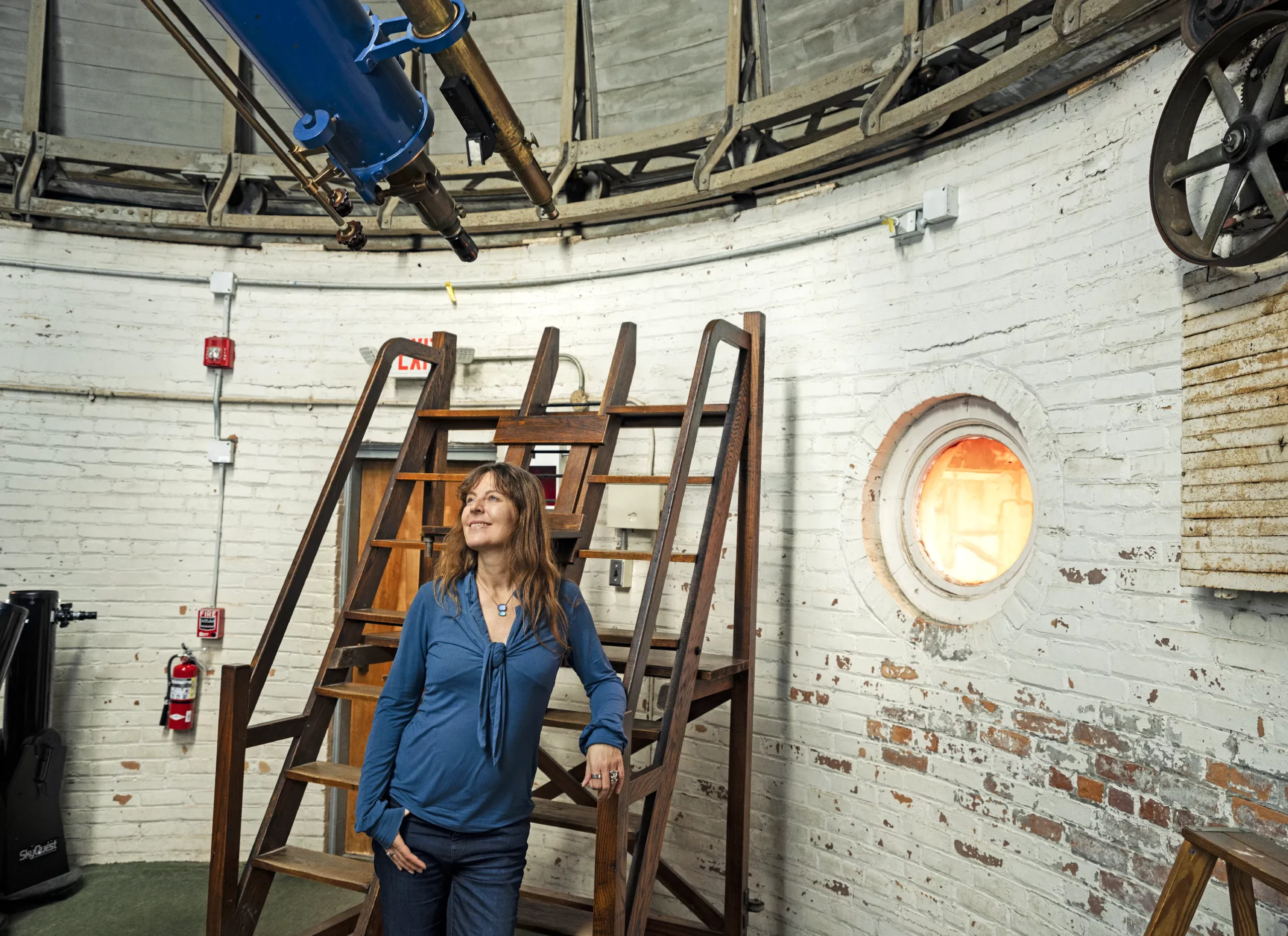
Kaltenegger at the Fuertes Observatory.
Sasha Maslov for Quanta Magazine
The European Space Agency scoped out its own version of a Earth twin-scouting, life-finding mission, called Darwin. Kaltenegger, then 24, applied to work on it and got the job. “I asked myself: If you live in a time where you can figure out if we are alone in the universe, and if I can help?” she said at Cornell, sporting a turquoise gem necklace symbolizing a pale blue dot and balancing a teacup on her knee. “Looking back on my life, that’s probably what I want to have done.” She was tasked with considering the mission’s design trade-offs and drafting the list of stars that Darwin’s fleet of telescopes should scan for planets; in parallel, she pursued her doctorate.
But in the 2000s, visions of grand alien-hunting telescopes crumbled on both sides of the Atlantic. Darwin studies fizzled in 2007. One reason was JWST’s own sagging development schedule, which ate up budgets and attention spans. Another was scientific doubt: At the time, astronomers had no clue what fraction of the Milky Way’s stars have rocky planets with the possibility of a stable, temperate climate.
That fraction would turn out to be about one in five, as revealed by the Kepler space telescope, which launched in 2009 and went on to discover thousands of exoplanets. A Terrestrial Planet Finder mission, should one be resurrected, would have plenty of places to point.
Since Kepler’s launch, though, pragmatic compromises have led astrobiologists to dream smaller, diverting their resources down a humbler path. An observatory like Darwin could have picked out the signal of a rocky planet next to a much brighter star — a challenge often compared to taking a picture of a firefly as it flits around a searchlight. But now there’s another, cheaper way.
Seager and the Harvard astronomer Dimitar Sasselov dreamed up the alternative method in 2000 — a way to sniff into an exoplanet’s atmosphere even if light from the planet and its star are blended together. First, telescopes look for planets that “transit,” crossing in front of their star as seen from Earth’s perspective, which causes a slight diminution in the starlight. These transits are rich with information. During a transit, a star’s spectrum sprouts new bumps and wiggles, because some of the starlight shines through the ring of atmosphere around the planet and molecules in the atmosphere absorb light of specific frequencies. Artful analysis of the spectral wiggles reveals the high-altitude chemistry responsible. The Hubble Space Telescope started testing this technique in 2002, finding sodium vapor around a faraway gas giant planet; along with other telescopes, it has since repeated the trick on dozens of targets.
Now the universe just needed to cough up some suitable Earth-like worlds to look at.
Exoplanet surveys seemed to encounter plenty of overcooked Jupiters and undersize Neptunes around other stars, but rocky planets with the potential for liquid water remained scarce until the Kepler era. By the mid-2010s, Kepler had shown that Earth-size worlds are common; it even spotted some potentially habitable ones transiting in front of their stars, like the pair Kaltenegger modeled for Borucki. Still, the specific examples Kepler turned up were too far away for good follow-up study. Meanwhile, in 2016 astronomers found that the nearest star to Earth, Proxima Centauri, has a potentially habitable Earth-size planet. But that planet doesn’t transit its star.
In 2009, Kaltenegger, then at Harvard and shaping the field in her own right, and a collaborator, Wesley Traub, added yet another qualification. They thought about what it would take for an alien civilization to detect biosignature gases on Earth — a planet with a relatively tight blanket of atmosphere, transiting a bright star. They realized that a telescope like JWST would see only tiny signals from atmospheric gases during each transit, so in order to achieve any statistical certainty, astronomers would need to observe dozens or even hundreds of transits, which would take years. Acting on this insight, astronomers started to seek Earths in close orbits around dimmer, colder red dwarf stars, where atmospheric signals will be less drowned out by starlight and transits repeat more frequently.
The cosmos came through. In 2017, astronomers announced the discovery of seven rocky planets around a red dwarf star called TRAPPIST-1. Then in September, the SPECULOOS-2 system emerged as a backup. These stars are close. They’re dim and red. They each have multiple rocky planets that transit. And as of the summer, the JWST is up and running even better than expected. It will spend a sizable fraction of the next five years staring hard at these messy globes of rock and chemicals spinning around their strange stars. For theoreticians like Kaltenegger who went from daydreaming of alternate Earths to churning out predictions about their atmospheric chemistry, decades of anticipation have given way to a slow fade-in of squiggly spectra on computer monitors.
Glowing Alien Lady
For over two years, Kaltenegger’s office — the same one Sagan used to work in — was frozen in time. First came the pandemic, then a sabbatical. In August, she was back, advancing on her whiteboard with a marker in hand, reviewing a list of ideas that wouldn’t look out of place in the writer’s room of a Star Trek series. (Gaia and SETI. Dark oceans. Ozone. Land. Shallow Oceans. Iron?) “This is the fun part,” she said, striking through the topics of papers she has already published.
Kaltenegger became the founding director of the Carl Sagan Institute in 2015 following stints at Harvard, then in Heidelberg, where she ran her first lab. One day during her time in Heidelberg, an email came in from Jonathan Lunine, now the head of the astronomy department at Cornell, asking if she wanted to talk about important opportunities. “I go, oh my God, it’s a ‘woman in science’ event. At a certain point, you get too many of those invitations.” Lunine was instead looking to hire a new professor. Kaltenegger responded that she would rather work at an interdisciplinary, astrobiology-focused institute. So lead one here, he suggested.
Samuel Velasco/Quanta Magazine
One recent morning we sat in a garden on campus not far from the institute, flanked by rhododendrons. As dappled sunlight filtered down, a little bird hopped up a tree trunk, a cicada buzzed, and the drone of a lawn mower moved nearer, then farther away. This was obviously an inhabited world.
Kaltenegger’s stock in trade is imagination: both the sort that astronomers trust when planning a $10 billion space telescope like JWST, and the more poetic kind that stirs public audiences. So what did this scene look like to her?
She glanced up. The trees had green leaves, as do most known organisms that perform photosynthesis. They had evolved to take advantage of our yellow sun and its bounteous visible-light radiation, using pigments that snatch up blue and red photons while letting green wavelengths bounce away. But plants around colder stars, greedier for light, might take on darker hues. “In my mind’s eye, if I want to, it just completely transforms with us in the garden, sitting under a red sun,” she said. “Everything is purple around you, behind you,” including the leaves.
Uncanny-valley versions of Earth have featured heavily in Kaltenegger’s thinking for two decades, owing to a nagging doubt she developed during her work on the Darwin mission in the early 2000s.
The goal at the time was to compare spectra from rocky, temperate planets to what Earth’s spectrum would look like from far away, seeking conspicuous signals like a surplus of oxygen due to widespread photosynthesis. Kaltenegger’s objection was that, for the first 2 billion years of Earth’s existence, its atmosphere had no oxygen. Then it took another billion years for oxygen to build up to high levels. And this biosignature hit its highest concentration not in Earth’s present-day spectrum, but during a short window in the late Cretaceous Period when proto-birds chased giant insects through the skies.
Without a good theoretical model for how Earth’s own spectrum has changed, Kaltenegger feared, the big planet-finding missions could easily miss a living world that didn’t match a narrow temporal template. She needed to envision Earth as an exoplanet evolving through time. To do this, she adapted one of the first global climate models, developed by the geoscientist James Kasting, which still includes references to the 1970s magnetic-tape era it originated in. Kaltenegger developed this code into a bespoke tool that can analyze not only Earth through time but also radically alien scenarios, and it remains her lab’s workhorse.
The day after our chat in the garden, I sat in the office next to Kaltenegger’s, looking over the shoulder of postdoc Rebecca Payne as we both squinted at tight lines of text on a black background. “If I don’t go with a black color scheme, by the end of the day my eyes want to fall out of my head,” she said.
Payne and her colleagues feed their software basic facts about a planet, such as its radius and orbital distance, and the type of its star. They then make guesses about its possible atmospheric composition, and run their models to see how the planet’s atmosphere would appear through the eons. When they did this for SPECULOOS-2c, they saw virtual chemicals bathed in virtual starlight rise, fall and annihilate each other through simulated chemical reactions. The imaginary atmosphere eventually settled into an equilibrium, and the software popped out a table. Payne pulled one up on the screen. She flicked her mouse over row after row, showing guesses at the new planet’s temperature and chemistry at varying altitudes. Using that information, she and her colleagues could identify especially abundant compounds that JWST or another instrument might be able to see.
From the Earth-through-time study on, many of Kaltenegger’s papers follow the same pattern. Her trick is to gather up what we know of Earth’s own richness in her theoretical palm, then spin it like a basketball along different axes. What if we rewound it in time? What if an alien Earth had different geology? A different atmosphere? An all-ocean surface? What if it circled a red sun, or the blazing-hot cinder of a white dwarf?
In 2010, for example, she found that the then-upcoming JWST should be able to infer the presence of gases from a volcanic eruption like the 1991 Mount Pinatubo eruption in the Philippines, if a similar event occurred on an exoplanet. Or it could identify worlds ruled not by the cycling of carbon between the surface and atmosphere (as on Earth), but instead by sulfur released by volcanoes and then broken down by starlight. Such climate cycles matter when you’re trying to identify biosignature gases, and also because they are part of the larger physics of planets. “Biosignatures are just sitting there as the cherry on top of the cake, but basically, there is a lot of cake to eat,” said Sasselov, who collaborated with Kaltenegger on these projects.
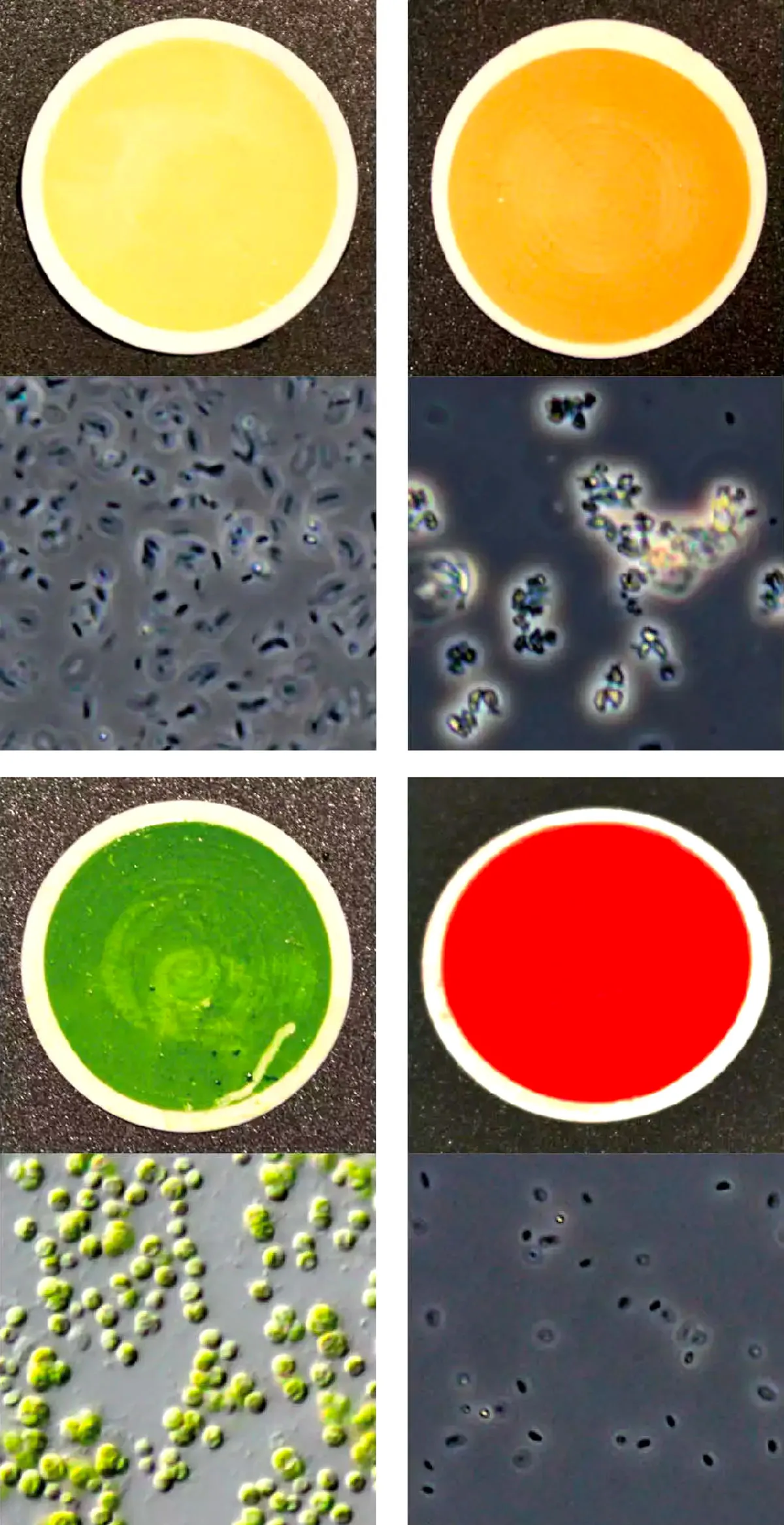
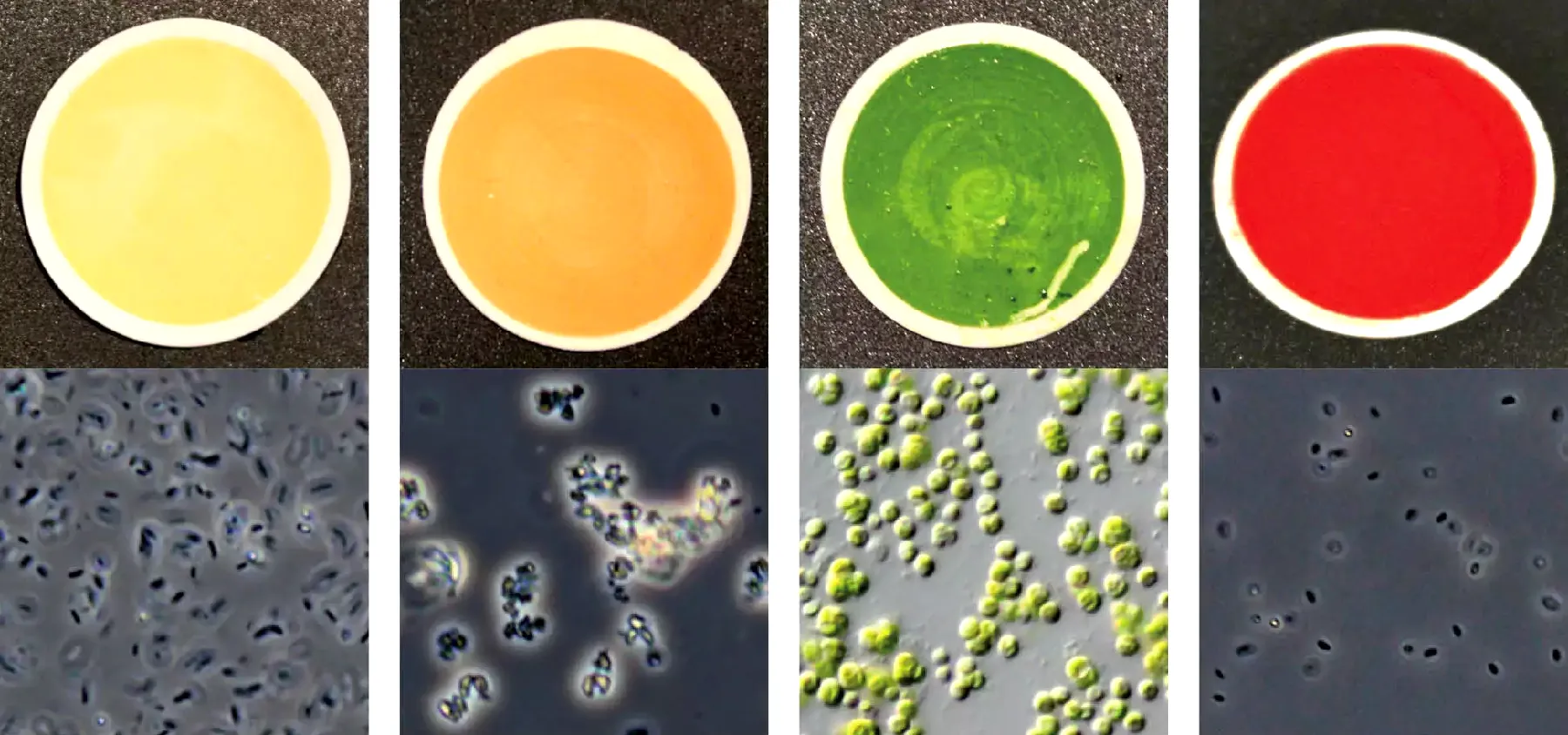
Kaltenegger’s catalog of biosignatures includes measurements of (from top left) Bacillus bacteria from Arizona’s Sonoran Desert; Arthrobacter from the Atacama Desert in Chile; sap from a white poplar tree; and Ectothiorhodospira from Big Soda Lake in Nevada.
Siddharth Hegde/MPIA
Kaltenegger’s catalog of biosignatures includes measurements of (from left) Bacillus bacteria from Arizona’s Sonoran Desert; Arthrobacter from the Atacama Desert in Chile; sap from a white poplar tree; and Ectothiorhodospira from Big Soda Lake in Nevada.
Siddharth Hegde/MPIA
Outside of her atmospheric modeling, Kaltenegger has also spent the last decade scouring the Earth to assemble something of an astrobiologist’s cabinet of curiosities: a public database of strange spectra. If astronomers do manage to find an anomalous wiggle in an exoplanet spectrum, her database could provide the key to deciphering it.
On a trip to Yellowstone National Park, for example, Kaltenegger marveled at multicolored microbial slicks on the surfaces of hot ponds. That led her and colleagues to cultivate 137 bacterial species in petri dishes, then publish their spectra. “There is probably not a color in the rainbow that you couldn’t find on Earth right now,” said Lynn Rothschild, a synthetic biologist at NASA’s Ames Research Center and a collaborator on the project. Inspired by a different colleague’s work drilling ice cores in the Arctic, Kaltenegger’s group isolated 80 cold-loving microbes similar to what might evolve on an ice planet, publishing a reference database of these spectra this March.
Other worlds might be biofluorescent. On Earth, biofluorescent organisms like corals protect themselves from ultraviolet light by absorbing it and re-emitting it as visible light. Given that planets in red dwarf star systems like TRAPPIST-1 are bathed in ultraviolet radiation, Kaltenegger argues that alien life there could evolve a similar process. (She has since been referred to as “that glowing alien lady.”) She also plans to obtain a series of spectra representing possible lava worlds; a geoscientist colleague and a newly arrived postdoc will soon start melting rocks.
As her publication list has grown, Kaltenegger has experienced both the opportunities and the indignities of a rising-star woman scientist. Once, when she was filming an IMAX short in Hawai‘i on the search for life, producers dressed her in shorts to match their notion of a scientist, Laura Dern’s Jurassic Park character; the decision then necessitated more makeup to cover all the mosquito bites.
Within a tight-knit field forced to share limited amounts of telescope time, she is an ebullient, warming presence, collaborators said. Her fingers weave through the air as she talks; sentences and stories tend to ramp up to big bursts of laughter. “She signs every text to me ‘hugs,’” said Rothschild. “I don’t have any other colleague who does that.”
First Dots on the Map
The first biosignatures will be tiny, ambiguous signals subjected to warring interpretations. In fact, some claims have already emerged.
The most pertinent case study rocked the astronomy world in the fall of 2020. A team including Seager announced that they had spotted an unusual compound called phosphine in the upper atmosphere of Venus, a sweltering, acid-washed planet typically dismissed as sterile. On Earth, phosphine is commonly produced by microbes. While some abiotic processes can also make the compound under certain conditions, the team’s analysis suggested those processes weren’t likely to occur on Venus. In their view, that left tiny floating Venusian organisms as a plausible explanation. “Life on Venus?” the New York Times headline wondered.

Kaltenegger in a park on the Cornell campus.
Sasha Maslov for Quanta Magazine
Outside groups formed opposing camps. Some experts, including Victoria Meadows, an exoplanet atmosphere modeler at the University of Washington who uses a similar approach to Kaltenegger’s, reanalyzed the Venus data and concluded that the phosphine signal was just a mirage: The chemical isn’t even there. Others, including Lunine at Cornell, argued that even if phosphine is present, it could, in fact, come from geologic sources.
Kaltenegger considers these critiques valid. In her view, the phosphine saga highlights a feedback loop between science and science funding that might entangle future candidate biosignatures too. At the time of the phosphine announcement, NASA was in the final stages of choosing between four small solar system missions, two of which were Venus-bound. By the following summer NASA announced that those two had been chosen to fly. The phosphine study “was a great way to get missions approved to Venus,” Kaltenegger said, breaking into laughter. “That’s the sarcastic take.” (Jane Greaves, the lead author of the phosphine study, said her team did not consider the mission selection process and the timing of the paper was a coincidence.)
The next phase in the hunt for exoplanet biosignatures hinges on what JWST reveals about the TRAPPIST-1 planets. Seeing actual biosignatures in their skies might be unlikely. But the telescope could detect carbon dioxide and water vapor in the sorts of ratios that the Earth- and Venus-based models predict. This would confirm that modelers have a decent handle on which geochemical cycles matter across the galaxy, and which worlds might truly be habitable. Seeing something more unexpected would help researchers correct their models.
A grimmer possibility is that these planets don’t have atmospheres at all. Red dwarf stars like TRAPPIST-1 are known to emit solar flares that could strip away everything but bare rock. (Kaltenegger doubts this, arguing that the planets’ gaseous emissions should keep replenishing their skies.)
By the second half of this decade, data from multiple planet transits will have piled up, enough for astronomers not just to look for chemistry on these worlds, but also to examine how given molecules wax and wane from season to season. By then complementary observations could add to the data. Several new, staggeringly large observatories are scheduled to open basin-size mirrors to the cosmos beginning in 2027 — including the biggest of all, the Extremely Large Telescope in Chile. These telescopes will be sensitive to different wavelengths of light than JWST is, probing an alternate set of spectral features, and they should also be able to study planets outside of transit.
All these instruments still fall short of what biosignature hunters really want, what they have always wanted: one of those giant space-based Terrestrial Planet Finders. Earlier this year, when the National Academy of Sciences released an influential, agenda-setting report called the decadal survey, which summarizes the astronomy community’s ideas of what NASA should prioritize, they effectively deferred a major push on the issue to the 2030s.
“I’ve been thinking about this: What about if it’s not us?” Kaltenegger said. “What if it’s not our generation?” Based on the soonest a true next-generation planet-hunting telescope could fly, she figures that the most likely candidate to lead such a mission is probably in grad school now.
Then again, her cohort of early exoplanet scientists have always been dreamers, she said. And science has always been an intergenerational activity.
Siting in her office that was Sagan’s, she sketched out a specific scene. A far-future voyager walks up the bridge of a departing spacecraft like the Enterprise, ready to travel to a new world. Kaltenegger is sure she won’t be on the ship herself, but, she said, “in my mind’s eye, I see them with this old star chart.” The antique map would mark the locations of candidate living planets. It would probably be outdated, brought along only for sentimental reasons. “But I want to be the person who put the first dots on this map.”
Correction: November 4, 2022
A previous version of this article included two photos incorrectly labeled as being taken in Kaltenegger’s office. Those photos have been replaced.



